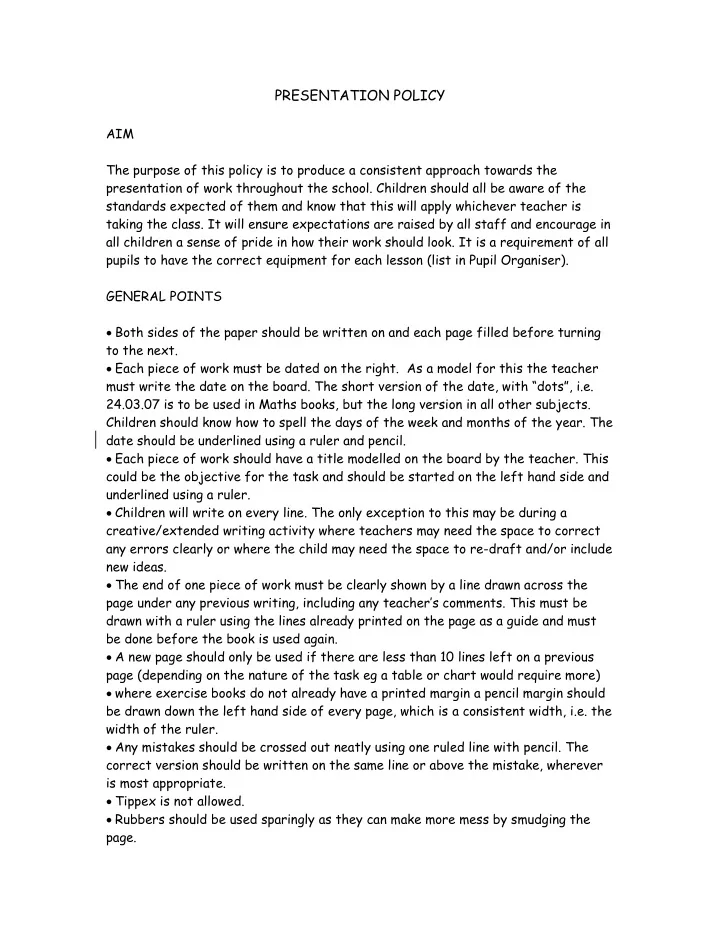

PRESENTATION POLICY AIM The purpose of this policy is to produce a consistent approach towards the presentation of work throughout the school. Children should all be aware of the standards expected of them and know that this will apply whichever teacher is taking the class. It will ensure expectations are raised by all staff and encourage in all children a sense of pride in how their work should look. It is a requirement of all pupils to have the correct equipment for each lesson (list in Pupil Organiser). GENERAL POINTS Both sides of the paper should be written on and each page filled before turning to the next. Each piece of work must be dated on the right. As a model for this the teacher must write the date on the board. The short version of the date, with “dots”, i.e. 24.03.07 is to be used in Maths books, but the long version in all other subjects. Children should know how to spell the days of the week and months of the year. The date should be underlined using a ruler and pencil. Each piece of work should have a title modelled on the board by the teacher. This could be the objective for the task and should be started on the left hand side and underlined using a ruler. Children will write on every line. The only exception to this may be during a creative/extended writing activity where teachers may need the space to correct any errors clearly or where the child may need the space to re-draft and/or include new ideas. The end of one piece of work must be clearly shown by a line drawn across the page under any previous writing, including any teacher’s comments. This must be drawn with a ruler using the lines already printed on the page as a guide and must be done before the book is used again. A new page should only be used if there are less than 10 lines left on a previous page (depending on the nature of the task eg a table or chart would require more) where exercise books do not already have a printed margin a pencil margin should be drawn down the left hand side of every page, which is a consistent width, i.e. the width of the ruler. Any mistakes should be crossed out neatly using one ruled line with pencil. The correct version should be written on the same line or above the mistake, wherever is most appropriate. Tippex is not allowed. Rubbers should be used sparingly as they can make more mess by smudging the page.
The use of pen or pencil is determined by the guidelines set out in the handwriting policy. Blue pen should be encouraged from Year 5 onwards, although pencil may be of more use in some lessons such as note taking or drafting. Blue pen should be used to produce “best” cop ies from Year 5 onwards. Only blue pens may be used in exercise books. School handwriting pens only should be used. Work for displays around the school should be written as a “best copy” in pen. A child should not write or draw ANYTHING on the covers of any exercise books. A child should not ”doodle” or in any other way mark any of the pages in their exercise books or on the cover. Felt tip pens and gel pens should not be used in any exercise books. Colouring pencils only should be used to colour in. Drawings or diagrams must be done in pencil and straight lines drawn with a ruler unless it is intended to be a rough sketch. If a plain page is needed this must be trimmed before being neatly stuck in. Refer to Appendix B for a list of subjects and the appropriate exercise books to be used. SPECIFIC SUBJECTS English See notes above which refer to pieces of extended writing. Question numbers should be recorded in the margins. Mathematics Numeracy work is to be recorded in pencil. A title may be a text book heading and page reference number. ALL lines should be drawn with a ruler; this includes answer lines for vertical calculations, tables, graphs and all straight sided shapes. For those children using squared pages, each digit should be written in a separate box to assist with understanding place value. All question numbers should be noted and shown by a bracket, e.g. 2) as dots can be confused with decimal points. Any corrections should be written out again as a new calculation, rather than being altered on the original calculation.
Science Rulers must be used for any diagrams that need straight sides represented. All diagrams and lines to label parts must be drawn in pencil but written labels can be written in ink if appropriate. Appendix A Examples of Presentation steps – to be displayed in all classrooms For every new piece of work – Step 1 – Rule off your last piece of work. Step 2 – Date and underline, with a ruler. Step 3 – Title and underline, with a ruler. Things to think about - Fill in the whole page Use a ruler and pencil when drawing straight lines Draw a margin neatly in pencil the width of your ruler on lined pages without a printed margin Always use colouring pencil to colour in Rule off after the last piece of work
Recommend
More recommend